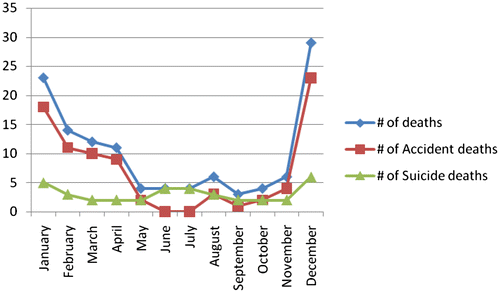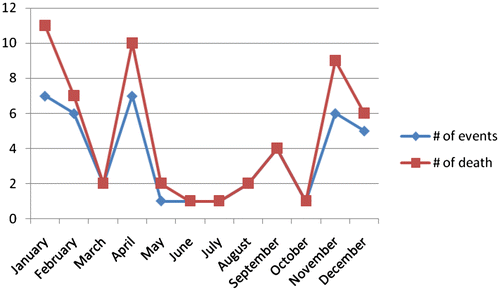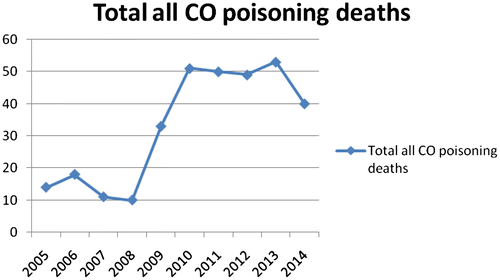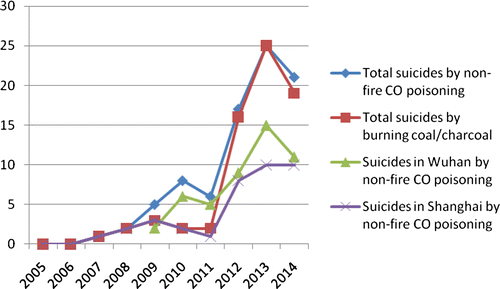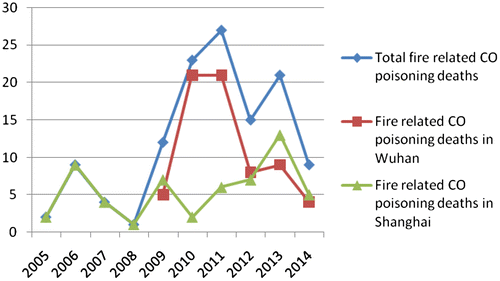Abstract
Carbon monoxide (CO) poisoning is a common cause of death globally. However, CO poisoning deaths in the Mainland China are rarely studied. Therefore, this study aims to explore the incidence trend of CO poisoning deaths that occurred in Pudong for a 10-year period (2005–2014). Using official police data, a total of 139 CO poisoning events that resulted in the death of 176 victims are collected. By comparing the data from Shanghai with the previous one from Wuhan, this study presents the most up-to date information about CO poisoning deaths that happened in China. The result indicates that the CO poisoning death rate in the study area in China is in the low level around the globe. Features of fire-related CO poisoning deaths are similar between the two mega cities, but in nonfire-related CO poisoning deaths, there are some distinguishing regional features. This study also found that the CO poisoning suicides by burning coal or charcoal is increasing sharply in recent years, especially in considering about the higher rate of burning charcoal suicides in the regions around the Mainland China. Certain precautious should be taken to prevent the growing trend of coal or charcoal burning suicides in future.
Public Interest Statement
The present research generates a public interest in a way to understand the trends and characteristics of carbon monoxide (CO) poisoning that occurred in Shanghai, which is the largest city in the Mainland China. Besides, by comparing the data collected in Wuhan, the largest city in the central Mainland China, this study presents a regional CO poisoning death trend in the Mainland China. Findings indicate that unlike most countries, showering gas accident is an important source of CO poisoning accidents in the Mainland China. Moreover, the usage of CO poisoning as a suicide method is growing in the Mainland China.
Competing interests
The authors declare no competing interest.
1. Introduction
Carbon monoxide (CO) is a product resultant of the incomplete organic materials combustion (Jaffe, Citation1997), which has a 200 to 270-time greater affinity for hemoglobin than oxygen (Fujisaki et al., Citation2014; Karapirli et al., Citation2013; Prockop & Chichkova, Citation2007). CO poisoning deaths can be classified as nonfire and fire-related CO poisoning deaths. In those fire-related CO poisoning deaths, some victims can be over 60% in COHb level; while on the other hand, some victims may have less than 10% (Yoshida, Adachi, Watabiki, Tatsuno, & Ishida, Citation1991). Besides, in the fire-related deaths, fire, COHb, or many other factors can contribute to the cause of death (Copeland, Citation1985). While in nonfire-related CO poisoning, the general toxicity mechanism of CO depends on its exceptional affinity for hemoglobin, which results in tissue hypoxia (Jaffe, Citation1997). Depending on the concentration of gas in the air, the length of exposure, and health conditions, CO effects can range from mild cardiovascular and neurobehavioral symptoms, to unconsciousness and death (Raub, Mathieu-Nolf, & Hampson, Citation2000; Risser & Schneider, Citation1995).
The CO poisoning deaths, both nonfire and fire-related, are well reported in the literature (Braubach et al., Citation2013; Choi, Cha, Chang, Khang, & Lee, Citation2014; Karapirli et al., Citation2013; Law, Yip, & Caine, Citation2011; Lin, Chang, & Lu, Citation2010). For example, in Chinese dominant regions, such as Hong Kong and Taiwan, CO poisoning deaths are receiving more attention by the local society, especially when CO poisoning has become the second frequently used method for suicides in recent years (Law et al., Citation2011; Lin et al., Citation2010; Liu et al., Citation2007). Therefore, it is pertinent to learn more about the deaths related to CO poisoning in the Mainland Chinese population for future preventive measures.
In the Mainland China, given the lack of a comprehensive death registration system, it has made the investigation of CO poisoning deaths a challenge. In this situation, there are usually five alternative methods for researchers to conduct research on unnatural deaths in the general population. Often time, empirical studies used the database from the Ministry of Health of the People’s Republic of China (MOH) to conduct research on the unnatural death rate in the Mainland China. However, these data only include gender and regional (urban/rural) information, with other essential information such as the detailed cause of death not included (Phillips, Li, & Zhang, Citation2002; Wang, Chan, & Yip, Citation2014). Therefore, it cannot be used to investigate unnatural death caused by CO poisoning. Although the Disease Surveillance Points (DSP), as the second most widely used database, have more detailed information that include the cause of death, this database nonetheless suffered from numerous misclassification problem (Chen, Chien-Chang Wu, Yousuf, & Yip, Citation2012; Sun, Guo, Zhang, Jia, & Xu, Citation2013; Wang et al., Citation2014; Yang et al., Citation2005). To illustrate, CO poisoning is commonly classified under the general poisoning category that mixed with many other poisoning deaths (Sun et al., Citation2013). Thus, the DSP database is not a viable source for research on topics related to CO poisoning deaths. The third method is by using the research laboratories’ data; however, the lab’s data is selective ones from a certain region, so it is not representative enough to be generalized to the larger population (Li et al., Citation2015; Zhang, Zhang, Zuo, & Liao, Citation2013; Zhou, Liu, Chang, & Li, Citation2011). The fourth method is through the use of surveying method, but this method often requires a large scale of human resources and financial support (Lu, Xiao, Xu, & Shi, Citation2013). The last method is through the use of the police and fire department data, which thus far is the most reliable source of CO poisoning deaths data. Of note, only a number of empirical studies on CO poisoning deaths are published based on the police and fire department data (Hu, Qin, Zhang, Tian, & Wan, Citation2004; Li et al., Citation2015; Wang & Song, Citation1998; Wang, Wang, Gong, Zhang, & Huang, Citation2011; Zhang, Citation1993), and no epidemiological study of CO poisoning deaths had been conducted in Shanghai. Hence, to fill the gap in the literature, this study aimed to examine the 10-year police data of Pudong District in Shanghai, from 2005 to 2014, by way to retrospectively investigate the CO poisoning deaths in a prime district of a mega city in the Mainland China. In addition, this study also intended to compare the trends observed in Shanghai with Li et al.’s (Citation2015) data of the six-year CO poisoning deaths collected in Wuhan. By doing so, this study will present the most up-to-date information about the CO poisoning deaths in the two mega cities in China.
2. Materials and methods
This research utilized the police data in the Pudong District in Shanghai. In the 2010 census, Pudong District recorded to have 5.04 million populations, which accounted for more than a quarter of the whole city population (Statistics Information of Shanghai, Citation2010). By using the police data, with the exception of several delayed CO poisoning deaths that occurred in hospitals (Li & Li, Citation2003), all other unnatural deaths due to CO poisoning were documented in the police data. The victim’s blood sample was screened for the presence of COHb by UV–vis spectrophotometry (Type: CARY 50 Probe, Varian). The blood alcohol level, hypnotic drugs, narcotic drugs, pesticide, and tetramine were examined based on the request of the on-scene legal physician, and those substances were tested by using Gas Chromatograph (7890A GC system, Agilent Technologies) Mass Spectrometer (5975C inertXL MSD, Agilent Technologies). 2 × 2 Chi-square (χ2) analyses were performed to in this study using SPSS (Version 18.0).
3. Results
3.1. Demographic features of CO poisoning deaths
In this 10-year period of examination, 139 CO poisoning events that resulted in the death of 176 victims were documented. There were 96 events of nonfire-related CO poisoning that resulted in the death of 120 victims. In general, the victim aged between two years and 91 years, with male and female victims averagely aged 36.43 years and 34.07 years, respectively. Fire-related CO poisoning deaths in Pudong District were based on estimation. This is because in some events, the COHb test records were unavailable, so it could not determine whether CO was involved in the cause of death. Hence, deaths that occurred in the fire scene without COHb records were not included in this study. There were 43 events of fire-related CO poisoning that resulted in 56 deaths. In general, the victim aged between two months and 91 years, with male and female victims averagely aged 42.77 years and 38.71 years, respectively.
3.2. Distribution of victims by months
As shown in , the highest nonfire-related CO poisoning deaths recorded was in the month of January, with 21 events resulted in the death of 23 victims; followed by December (20 events with 29 victims) and February (11 events with 14 victims); months with the least events were in May, June and July, with four deaths in each month. In terms of the seasons, most deaths were recorded during the winter, and least was recorded in the summer. The trend of accidental deaths due to nonfire-related CO was in accordance with all nonfire-related CO poisoning death. As to the suicides in nonfire-related CO poisoning deaths, it was more likely to be equally distributed in each month, although it was still highest during the winter ().
Table 1. Months of nonfire-related CO poisoning deaths
As shown in , January had the highest fire-related CO poisoning deaths (7 events with 11 victims), followed by November (6 events with 9 victims) and April (7 events with 10 victims). The months with least events were May, June, and July, with only one event per month that resulted in four deaths in total. The trend of fire-related CO poisoning deaths was also found to be highest in the winter and lowest during the summer ().
Table 2. Months of fire related CO poisoning deaths
3.3. Manners of death in nonfire-related CO poisoning deaths
reveals the rates of accidental and suicidal nonfire-related CO poisoning deaths, which account for 69.17% (N = 83) and 30.83% (N = 37), respectively. Notably, none of the CO poisoning deaths were classified as a homicide. In addition, the mean age of female suicidal deaths (29.63 years) was much lower than their male counterparts (34.57 years). Clearly, this shows that young females were more at risk in suicidal CO poisoning than males of similar age. Among all nonfire suicidal CO poisoning deaths, coal or charcoal burning was the most commonly employed method (97.30%), with the exception of only one death that was caused by CO stored in a balloon. In terms of the accidental nonfire-related CO poisoning deaths, gas showering accidents were the most commonly found incidents (62.65%), and followed by coal or charcoal burning (18.07%).
Table 3. Manner of death and source of CO in nonfire-related CO poisoning deaths
3.4. Manners of death in fire-related CO poisoning deaths
Fifty-six deaths were recorded in the fire-related CO poisoning. Specifically, three deaths were from three suicidal events by arson, while the rest were ruled to be accidents.
3.5. The laboratory examination
Seventy-eight victims out of 120 had COHb records in nonfire-related CO poisoning (65%). Among them, 39 males were recorded a mean COHb at 56.91% (SD: 12.22%) and 39 females were found to have a mean at 59.40% (SD: 15.00%). Eight males and one female were positive in blood alcohol. Besides, two females were positive on estazolam, and one male was positive on tetrahydropalmatine. In addition, 56 victims had COHb records in the fire-related CO poisoning deaths. Among them, 35 males had a mean COHb at 43.92% (SD: 21.49%), and 21 females had a mean at 38.11% (SD: 13.96%). Besides, seven deaths were found to be positive in their blood alcohol.
3.6. Statistical comparison between Shanghai and Wuhan in CO poisoning deaths
As the population numbers in both Shanghai and Wuhan are growing, the population numbers that were used in this study were those reported in the sixth nationwide census in 2010 (Statistics Information of Shanghai, Citation2010; Statistics Information of Wuhan, Citation2011). Besides, the number of CO poisoning deaths in each year was relatively small, and also to achieve the consistence of the two places, the original numbers were calculated as numbers in five million people for 10 years’ period for the comparison. Statistical comparison analyses showed in fire-related CO poisoning deaths in both Shanghai and Wuhan were not significantly different (). However, in nonfire-related CO poisoning, there were three significant differences, namely the manner of death, the sources of CO, and the suicide methods ().
Table 4. Statistical comparison of fire-related CO poisoning between Shanghai and Wuhan
Table 5. Statistical comparison of nonfire-related CO poisoning deaths between Shanghai and Wuhan
3.7. The trends in CO poisoning
By combining the events in Shanghai and Wuhan together, Figures – showed the trends in CO poisoning deaths. From 2005 to 2008, the population pool was 5.04 million made up Shanghai only. In 2009, the combined population pool had 7.78 million in both cities—Shanghai and Wuhan. From 2010 to 2014, the combined population pool had 12.29 million. The time trend of all CO poisoning deaths in two cities was steady. Furthermore, the fire-related CO poisoning deaths and the nonfire-related accident CO poisoning deaths were decreased, but the nonfire-related suicide CO poisoning deaths were found to be increased during the period of examination.
4. Discussion
To the authors’ knowledge, this study is arguably one of the first few studies that published on the CO poisoning deaths recorded in Shanghai. In this 10-year study (2005–2014) of CO poisoning deaths in Shanghai, many finding were consistent with previous studies (Braubach et al., Citation2013; Choi et al., Citation2014; Karapirli et al., Citation2013; Law et al., Citation2011; Lin et al., Citation2010). To illustrate, the winter was the most likely occurred season of the year, elders were the most suspicious age group to be killed in CO poisoning, and the mean COHb level of the victims were between 40 and 50%. Although there were not groundbreaking findings in the pathology of CO poisoning deaths found in this study, this study was considered as the most comprehensive epidemiological study on CO poisoning deaths in the Mainland China thus far.
4.1. The annual CO poisoning death rate in the general population
By using Wuhan’s (Li et al., Citation2015) and Shanghai’s data, with a combined population over 12 million, this study examined the CO poisoning death trends in the two mega cities in middle and lower reaches of Yangtze River in China. In Wuhan, CO poisoning death rate was .492 per 100,000 people per year (Li et al., Citation2015). In Pudong District of Shanghai, CO poisoning death rate was .349. With the combined rates of both cities, the CO poisoning death rate was .375 in the study area in China. This rate was relatively comparable with those reported in Belgium at .38, but was much lower than in most other nations (Braubach et al., Citation2013). Moreover, the nonintentional and nonfire CO-related death rate was .135 in the study area in China, close to the rate of .15 that was reported in the United States, but was much lower than those reported in the European countries and Quebec providence in Canada (Braubach et al., Citation2013). However, in view of the lack of a nationwide death registration in the Mainland China, the national CO poisoning death rate is unknown. It is not impossible that some jurisdictions may record a much higher CO poisoning rate than the two cities examined in this study. Therefore, further comprehensive research on CO poisoning deaths in the Mainland China is desired.
4.2. Features of nonfire-related CO poisoning death in different geographical regions
This study also revealed some features of CO poisoning deaths in the fire accidents were relatively similar in both Shanghai and Wuhan with 500 miles distance. However, in the nonfire-related CO poisoning deaths, there were regional differences. In Shanghai, accidents were much higher than suicides in CO poisoning. To exemplify, the number of gas showering accidents in Shanghai (N = 52) were much higher than those reported in Wuhan (N = 11). Additionally, the improper installation of gas showering heater was found to be a key feature for those accidents occurred in Shanghai; on whether it was wrongly installed in the bathroom or in other places without sufficient air exchange. Therefore, 37 events of CO produced by the incomplete combustion resulted in 52 deaths. It is interesting to note that gas showering accidents were the most frequently reported CO source of CO poisoning death in Shanghai given no studies or reports from other nations emphasized on gas showering as a source (Braubach et al., Citation2013; Copeland, Citation1985; Karapirli et al., Citation2013; Law et al., Citation2011; Lin et al., Citation2010). Besides, despite the number of gas showering accidents being much lower in Wuhan compared with those in Shanghai, it nonetheless was recorded as the third frequently used source in all nonfire CO poisoning deaths (Li et al., Citation2015). Therefore, this study has revealed an important safety issue of using gas showering in the Mainland China. In order to reduce the mortality rate due to gas showering accidents, a national standard on the installation of gas showering heater should be registered and strictly enforced.
4.3. Suicide by coal or charcoal burning
In terms of suicides, coal or charcoal burning was the most commonly used method for suicide by CO poisoning in both cities, but Wuhan was found to have reported another alternative method—gas leaking—in suicidal methods (Li et al., Citation2015). Moreover, CO poisoning suicides by vehicular exhaust were common in western nations, such as Sweden and the United States (Öström, Thorson, & Eriksson, Citation1996; Schmitt, Williams, Woodard, & Harruff, Citation2011). In a sharp contrast, this suicidal method was not found to be a common feature in Shanghai and Wuhan. Hence, with all these features, the trends in nonfire-related CO poisoning deaths in the Mainland China are relatively different from many other nations.
shows the first event of coal or charcoal burning suicide appeared in Shanghai in 2007, the third year in this study. Moreover, before 2010, all six suicides by coal or charcoal burning were not indigenous residents, including two from Hong Kong and four from other parts of the Mainland China. Only until 2010, the fifth year of study, the first indigenous resident committed suicide by coal or charcoal burning. After the first one, fifteen more indigenous residents used the same method to commit suicide. While in Wuhan, although the origin of the residents was unknown, the first one committed suicide by coal or charcoal burning has recorded in 2011, the third year of Li et al.’s study (Citation2015). Based on these findings, it can further imply that coal or charcoal burning was not a common method used for suicide in the Mainland China originally; but gradually, the Mainland Chinese started to employ this method. In the 10-year of study period, the highest year of suicides by this method was in 2013, with 25 deaths in total in Wuhan and Shanghai. Combined the data of Shanghai and Wuhan (Li et al., Citation2015), there were 70 suicidal deaths by burning coal or charcoal in total. If calculated by sampling years and populations of the two cities, as well as considering about national suicide rate reported by Wang et al. (Citation2014), suicide by coal or charcoal burning was not a popular employed suicide mean. Although it was a relatively low number, the trend reported in this study has clearly suggested a growing trend in coal or charcoal burning suicides in recent years. It has gradually replaced the gas leaking suicides in Wuhan. For a consideration, in Hong Kong, when the first suicide by charcoal burning happened in November 1998, it is interesting to note that 22 suicides were found using the same method in the following nine weeks (Chung & Leung, Citation2001). Surrounded by Hong Kong, Taiwan, and Korea, regions with high in suicides by charcoal burning (Choi et al., Citation2014; Law et al., Citation2011; Lin et al., Citation2010), the suicides by coal or charcoal burning may experiencing a growing trend in the Mainland China. The media was found to be an important means to distribute messages with regard to the suicide method of burning coal or charcoal in Hong Kong (Chung & Leung, Citation2001). Therefore, it may be appropriate not to report too often of such related messages by the Mainland Chinese media.
4.4. Age in suicide by burning coal or charcoal
The study in Hong Kong suggested that the age group between 24 and 39 is the most dangerous age group in committing suicide with charcoal burning (Liu et al., Citation2007). In Shanghai, 29 out of 36 events (80.56%) were reported in this age group. However, only 19 out of 34 events (55.88%) of this age group were found in Wuhan. Interestingly, the prevalence rate reported in the Mainland China was found to be much higher than those reported in Hong Kong. Therefore, further research is required to explore the reasons behind such a growing trend in coal or charcoal burning suicide in the Mainland China.
5. Conclusions
Carbon monoxide poisoning is one of the most common intoxications. Using a total sample of 176 deaths due to CO poisoning for a period of 10 years, this study is arguably the first to examine the trends of CO poisoning deaths in Shanghai. By examining the data of Shanghai and Wuhan, this study suggests that the CO poisoning death rate was in a low-level in the middle and lower reaches of Yangtze River in China. Moreover, findings of the nonfire-related CO poisoning deaths indicate that the key features in the Mainland China are different from studies conducted in other nations. At last, this study reveals a recent trend that CO poisoning suicides by coal or charcoal burning are growing in the Mainland China.
Additional information
Funding
Notes on contributors
Xuesong Lu
Xuesong Lu is currently working as a legal physician in Shanghai public security bureau.
References
- Braubach, M., Algoet, A., Beaton, M., Lauriou, S., Héroux, M. E., & Krzyzanowski, M. (2013). Mortality associated with exposure to carbon monoxide in WHO European Member States. Indoor Air, 23, 115–125. doi:10.1111/ina.12007
- Chen, Y. Y., Chien-Chang Wu, K. C., Yousuf, S., & Yip, P. S. F. (2012). Suicide in Asia: Opportunities and challenges. Epidemiologic Reviews, 34, 129–144. doi:10.1093/epirev/mxr025
- Choi, Y. R., Cha, E. S., Chang, S. S., Khang, Y. H., & Lee, W. J. (2014). Suicide from carbon monoxide poisoning in South Korea: 2006–2012. Journal of Affective Disorders, 167, 322–325. doi:10.1016/j.jad.2014.06.026
- Chung, W. S. D., & Leung, C. M. (2001). Carbon monoxide poisoning as a new method of suicide in Hong Kong. Psychiatric Services, 52, 836–837. doi:10.1176/appi.ps.52.6.836
- Copeland, A. R. (1985). Accidental fire deaths, the 5-year metropolitan Dade Country experience from 1979 until 1983. Zeitschrift fuer Rechtsmedizin, 94, 71–79. doi:10.1007/bf00200525
- Fujisaki, N., Atsunori, N., Takaaki, O., Takeshi, N., Taihei, Y., Keisuke, K., … Joji, K. (2014). Can carbon monoxide-poisoned victims be organ donors? Medical Gas Research, 7, 1–4. doi:10.1186/2045-9912-4-13
- Hu, J. W., Qin, C. X., Zhang, J., Tian, C. X., & Wan, G. (2004). 52 Cases of bodies in fire scene. Chinese Journal of Forensic Medicine, 19, 89–91.
- Jaffe, F. (1997). Pathogenicity of carbon monoxide. The American Journal of Forensic Medicine and Pathology, 18, 406–410. doi:10.1097/00000433-199712000-0001710.1097/00000433-199712000-00017
- Karapirli, M., Kandemir, E., Akyol, S., Kantarci, M. N., Kaya, M., & Akyol, O. (2013). Forensic and clinical carbon monoxide (CO) poisonings in Turkey: A detailed analysis. Journal of Forensic and Legal Medicine, 20, 95–101. doi:10.1016/j.jflm.2012.04.031
- Law, C. K., Yip, P. S. F., & Caine, E. D. (2011). The contribution of charcoal burning to the rise and decline of suicides in Hong Kong from 1997–2007. Social Psychiatry and Psychiatric Epidemiology, 46, 797–803. doi:10.1007/s00127-010-0250-y
- Li, F., Chan, H. C. O., Liu, S. H., Jia, H. P., Li, H. J., Hu, Y. Z., … Huang, W. (2015). Carbon monoxide poisoning as a cause of death in Wuhan, China: A retrospective six-year epidemiological study (2009–2014). Forensic Science International, 253, 112–118. doi:10.1016/j.forsciint.2015.06.007
- Li, Y. M., & Li, X. M. (2003). Carbon monoxide poisoning and hyperbaric oxygen treatment of delayed encephalopathy. Clinical Medical Journal of China, 10, 660–661.
- Lin, J. J., Chang, S. S., & Lu, T. H. (2010). The leading methods of suicide in Taiwan, 2002–2008. BMC Public Health, 10, 480. doi:10.1186/1471-2458-10-480
- Liu, K. Y., Beautrais, A., Caine, E., Chan, K., Chao, A., Conwell, Y., … Yip, P. (2007). Charcoal burning suicides in Hong Kong and urban Taiwan: An illustration of the impact of a novel suicide method on overall regional rates. Journal of Epidemiology and Community Health, 61, 248–253. doi:10.1136/jech.2006.048553
- Lu, J., Xiao, Y., Xu, X., & Shi, Q. (2013). The suicide rates in the Yunnan Province, A multi-ethnic province in Southwestern China. The International Journal of Psychiatry in Medicine, 45, 83–96. doi:10.2190/pm.45.1.g
- Öström, M., Thorson, J., & Eriksson, A. (1996). Carbon monoxide suicide from car exhausts. Social Science and Medicine, 42, 447–451. doi:10.1016/0277-9536(95)00104-2
- Phillips, M. R., Li, X. Y., & Zhang, Y. P. (2002). Suicide rates in China, 1995–99. The Lancet, 359, 835–840. doi:10.1016/s0140-6736(02)07954-0
- Prockop, L. D., & Chichkova, R. I. (2007). Carbon monoxide intoxication: An updated review. Journal of the Neurological Sciences, 262, 122–130. doi:10.1016/j.jns.2007.06.037
- Raub, J., Mathieu-Nolf, M., & Hampson, N. (2000). Carbon monoxide poisoning—A public health perspective. Toxicology, 145, 1–14. doi:10.1016/s0300-483x(99)00217-6
- Risser, D., & Schneider, B. (1995). Carbon monoxide-related deaths from 1984 to 1993 in Vienna, Austria. Journal of Forensic Science, 40, 368–371.
- Schmitt, M. W., Williams, T. L., Woodard, K. R., & Harruff, R. C. (2011). Trends in suicide by carbon monoxide inhalation in King County, Washington: 1996–2009. Journal of Forensic Sciences, 56, 652–655. doi:10.1111/j.1556-4029.2010.01688.x
- Statistics Information of Shanghai. (2010). Population status in Shanghai. Retrieved from http://www.stats-sh.gov.cn/sjfb/201203/239823.html
- Statistics Information of Wuhan. (2011). Population status in Wuhan. Retrieved from http://www.stats-hb.gov.cn/wzlm/tjgb/rkpcgb/fz/11028.htm
- Sun, J. D., Guo, X. L., Zhang, J. Y., Jia, C. X., & Xu, A. Q. (2013). Suicide rates in Shandong, China, 1991–2010: Rapid decrease in rural rates and steady increase in male–female ratio. Journal of Affective Disorders, 146, 361–368. doi:10.1016/j.jad.2012.09.020
- Wang, A. Q., & Song, D. J. (1998). 36 Cases of CO poisoning. Law and Medicine, 5, 180.
- Wang, C. W., Chan, C. L. W., & Yip, P. S. F. (2014). Suicide rates in China from 2002 to 2011: An update. Social Psychiatry and Psychiatric Epidemiology, 49, 929–941. doi:10.1007/s00127-013-0789-5
- Wang, Y. B., Wang, L. L., Gong, D. Y., Zhang, C. C., & Huang, F. J. (2011). 49 Cases of CO poisoning analysis. Chinese Journal of Forensic Medicine, 26, 471–473.
- Yang, G., Hu, J., Rao, K. Q., Ma, J., Rao, C., & Lopez, A. D. (2005). Mortality registration and surveillance in China: History, current situation and challenges. Population Health Metrics, 3, 1–9.
- Yoshida, M., Adachi, J., Watabiki, T., Tatsuno, Y., & Ishida, N. (1991). A study on house fire victims: Age, carboxyhemoglobin, hydrogen cyanide and hemolysis. Forensic Science International, 52, 13–20. doi:10.1016/0379-0738(91)90091-v
- Zhang, D., Zhang, J., Zuo, Z., & Liao, L. (2013). A retrospective analysis of data from toxic substance-related cases in Northeast China (Heilongjiang) between 2000 and 2010. Forensic Science International, 231, 172–177.10.1016/j.forsciint.2013.05.014
- Zhang, R. S. (1993). 95 Cases analysis of blood in bodies. Chinese Journal of Forensic Medicine, 8, 94–96.
- Zhou, L., Liu, L., Chang, L., & Li, L. (2011). Poisoning deaths in central China (Hubei): A 10-year retrospective study of forensic autopsy cases. Journal of Forensic Sciences, 56, S234–237.10.1111/jfo.2010.56.issue-s1

